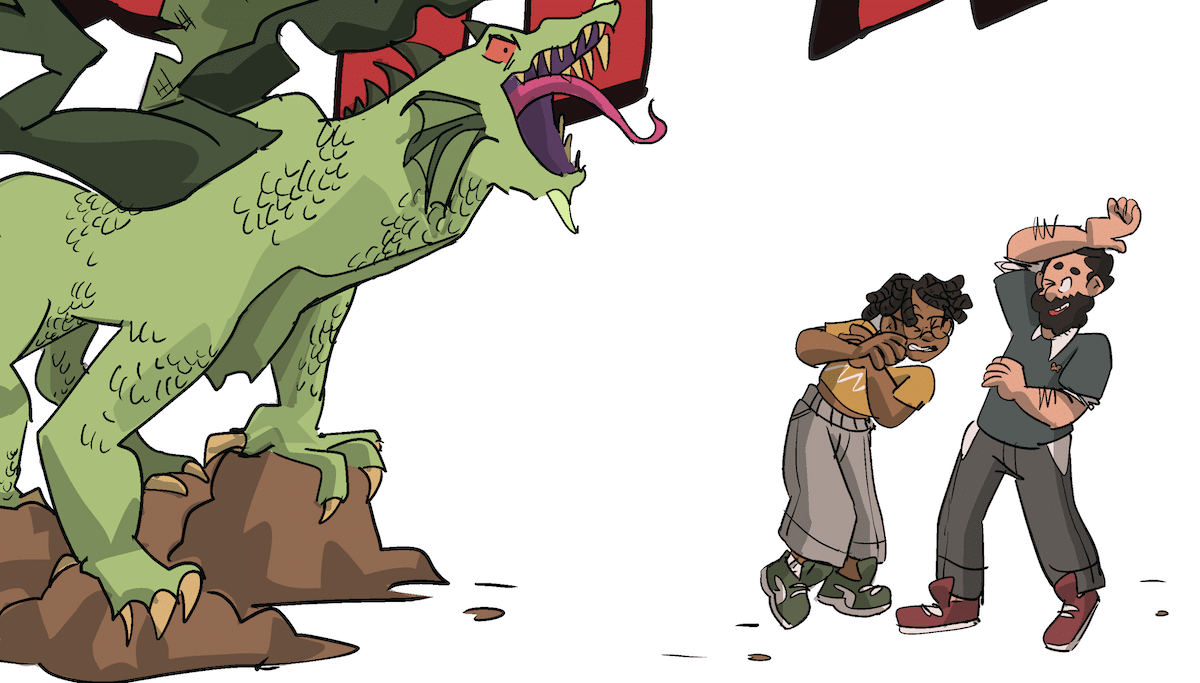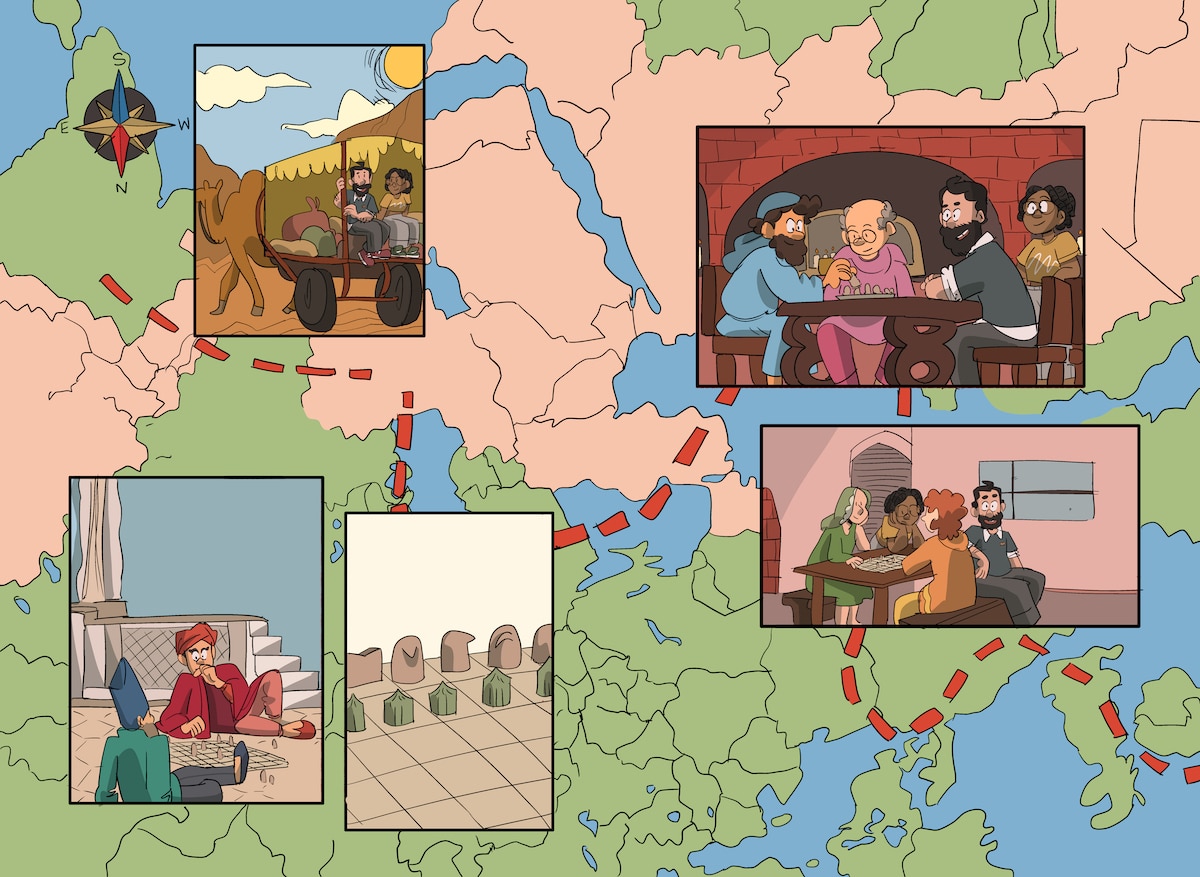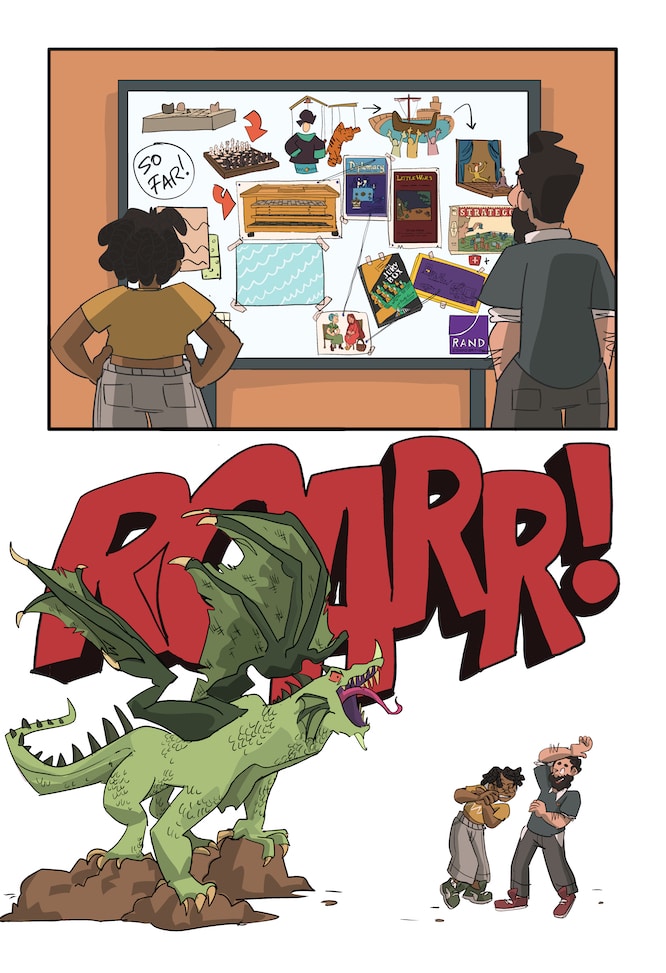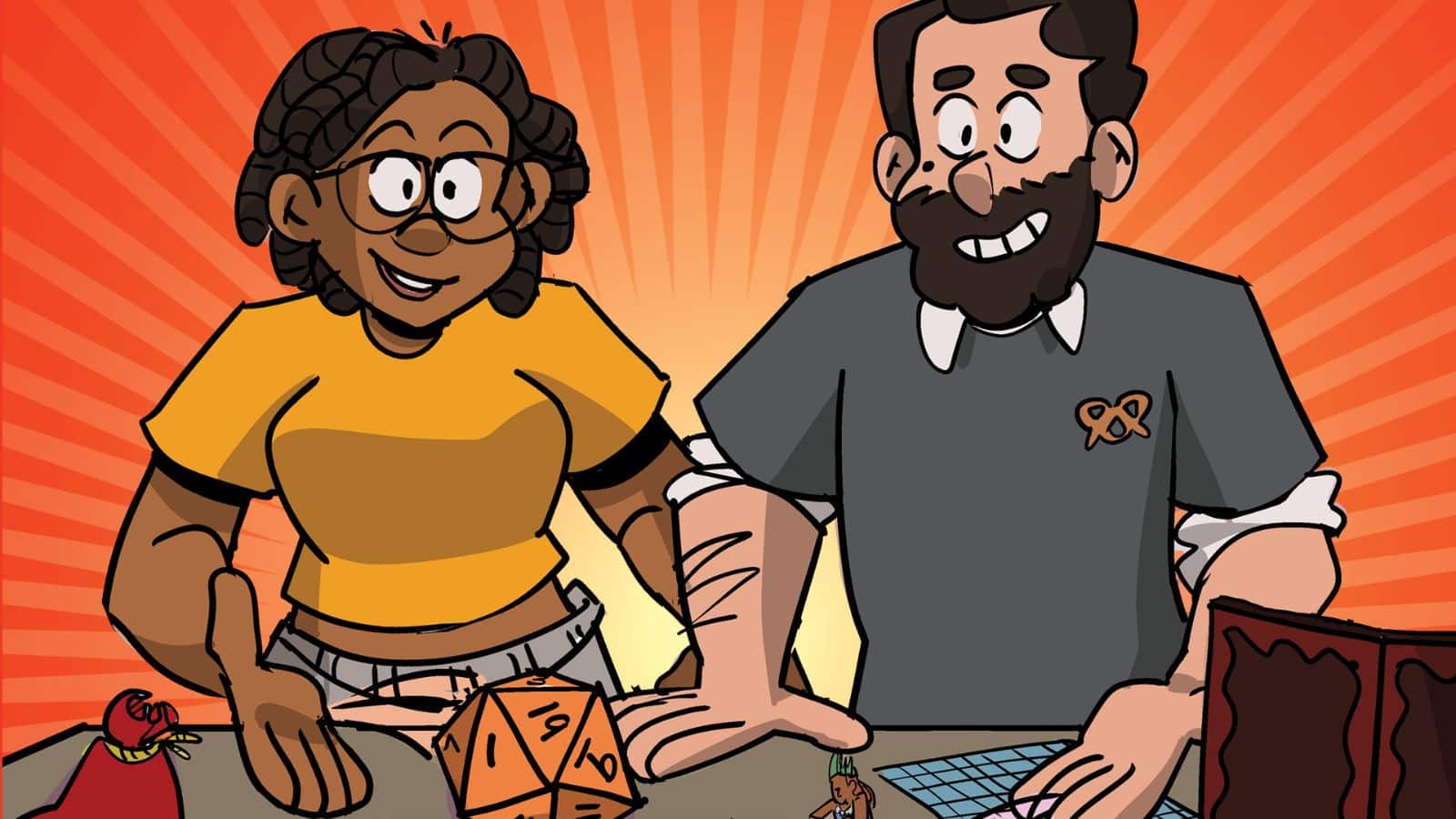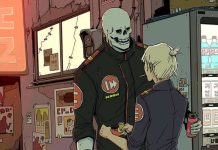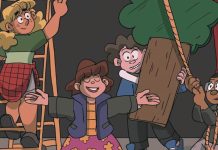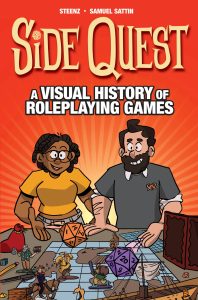
On October 8th, 2024, Side Quest: A Visual History of Tabletop Games by Steenz and Samuel Sattin will be published. On Monday, Comics Beat was proud to reveal the nonfiction graphic novel’s cover. Today, we’re pleased to present this interview with Sam and Steenz.
The Beat asked all about researching Side Quest, about their favorite pages from the book, and about their personal experience with TTRPGs! Be sure and let us know in the comment section if you’re planning on picking up Side Quest when it arrives this autumn.
AVERY KAPLAN: What kind of research went into this nonfiction graphic novel? Did any topic or piece of information pose a particular challenge, for whatever reason?
STEENZ: I had some challenges finding references for things before the mid-20th century when photography was being used en masse. So I utilized tapestries and vases and illustrations for my references. Which was pretty fun! Also finding photos of members of some of the early clubs like the Society for Creative Anachronism. But you do what you can with what you’ve got!
SAM SATTIN: I spent months sifting through all the scholarship I could find; not just on tabletop roleplaying games, but on analog games in general, psychotherapy, and community theater. Jon Peterson’s book PLAYING AT THE WORLD is an amazing resource, for one. And I went through a lot of academic papers. The most challenging part for me in terms of research was attempting to nail down certain ritual and cultural activities during the Han Dynasty (202 BCE – 220 CE). I had to cross-section a lot of material, and even then, you have to admit to yourself that–due to the time period and available material–you can’t be 100% sure you got it right.
AVERY: What did your collaborative process look like for Side Quest?
STEENZ: Sam did a LOT of the research heavy lifting. And after the first draft of the script was done, I went through it with an editorial hand and tied some things together, cut some things out. I made sure our voices sounded realistic and not like we were just reading from an essay of information haha. And then after the script was finalized, Sam did the majority of Art References. Finding photos of writers, scientists, original board game designs, letters, all that good stuff. And then I took about 2 years to draw the book. When you’re drawing fiction you can use a lot of artistic license to get your idea across. But with non-fiction everything has to be right. I think that’s what took me the longest, was finding ways to simplify and cartoon these real people, and making sure that we represented history correctly. It’s a lot!
SAM: Yes! The collaborative effort really did take place in two parts. I spent a lot of my time frontloading research and reference (and then writing the script). Then Steenz picked up from there, editing the script for visual consistency in a way that would function. There was a lot of rearranging, cutting, rebuilding, and restructuring. Then Steenz went in and did the hard work of drawing the actual book! This is especially difficult, when considering, as Steenz says, that non-fiction relies on accuracy. That’s one thing when you’re talking about writing. But when you get into the visual realm, you have to combine visual accuracy with your style as an artist. It’s heavy lifting, and requires a ton of attention to detail.
AVERY: Did you have any creative routines or rituals you relied on while working on Side Quest?
STEENZ: I started making zines to get back into drawing for fun. To be frank, drawing isn’t always fun when you’re doing it for work. And there’s a lot of stress that comes with representing ideas, people, places, and historical objects correctly. So drawing for fun in a small and low stakes way helped a lot.
SAM: For me, I just had to make sure that I had my nose in a book every day for as long as I could manage. And I got more skilled in sourcing information from academic journals, and tracking my sources for the bibliography.
AVERY: How did working on Side Quest compare to your other respective sequential graphic narrative projects?
STEENZ: This is the first project I’ve worked on where we both worked on the script! I really enjoyed the process of taking Sam’s words and zhuzhing them up lol. But it was also much harder to draw this than my previous work. There’s just a lot of details. And finding the balance between regurgitating researched information and providing an engaging narrative was also hard!
SAM: Unlike most of my projects, SIDE QUEST was built entirely on research. As a category of study, history is fairly immutable; you have to humble yourself in order to make sure that you’re not taking shortcuts or skipping over gaps in your knowledge. It’s kind of forensic that way . So if you set out to prove a point (in SIDE QUEST’s case, that TTRPGs can be traced back to the ancient world) the research has to back you up. It’s more like writing a dissertation than a work of fiction.
AVERY: Is there any page or panel from Side Quest that stands out as a favorite to you?
STEENZ: I really love this page. It was a lot of fun to draw as it was my first detailed spread of the book.
SAM: This page, of course. For obvious dragon-related reasons.
AVERY: Do you have any personal TTRPG stories or anecdotes you’d be willing to share with us?
STEENZ: Yeah! I had played a lot of different kinds of TTRPGs, but never was interested in high fantasy. You know, wizards and goblins and the hero’s journey lol. But recently I played Vampire The Masquerade as Columbo if he was a vampire. And it was some of the most fun I’ve ever had playing TTRPGs. It’s just nice to know that you can involve yourself in make believe without it having to be about elves and shit LOL
SAM: I GM’d an amazing campaign full of cartoonists for a couple of years whose members included Maia Kobabe and Meggie Ramm. It was a blast, and I miss it. It was homebrewed, so I got to create this big wild world and fill it with stories and characters. And the players always foiled my carefully set up plans and went completely rogue…it was so good for my writing brain, to have to deal with the unexpected, and try to account for it in turn.
I tried to restart another group recently with some of the original players from the previous one involved, but work hit me like a ton of bricks so I haven’t been able to keep it going. I hope to get back to it.
AVERY: Were there any comics (or any other kind of stories) that were particularly influential to you while working on this project?
STEENZ: I just love non fiction graphic novels. So I definitely put on my Box Brown hat and tried to provide a narrative as compelling as Andre The Giant and Is This Guy For Real: The Unbelievable Andy Kaufman.
SAM: Box Brown books for sure. He’s the master. And the massive biography of Osamu Tezuka (THE OSAMU TEZUKA STORY by Toshio Ban).
AVERY: What do you hope readers will take away from Side Quest?
STEENZ: I hope it inspires more people to play TTRPGs. There’s a whole world out there outside of Dungeons and Dragons. You can find your place in that community.
SAM: I hope it demonstrates how storytelling and play are some of the oldest forms of human expression. TTRPGs might seem like a modern invention, but they come from the ancient world.
AVERY: Is there anything else you’d like me to include?
STEENZ: There’s a homebrew short campaign that we’ve created for our readers! Without spoiling too much, there’s a sci-fi TTRPG that Book Sam and Book Steenz plays and you’ll get to play in that world as well!
SAM: Agreed! Check out the short campaign at the end and give it a shot. And most importantly, have fun!
Side Quest: A Visual History of Tabletop Games will be available at your local bookstore and/or public library beginning on October 8th, 2024.


